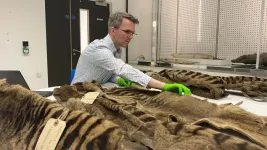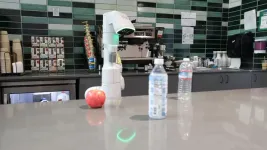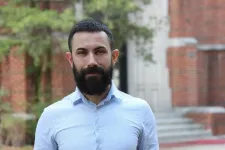(Press-News.org) First author Cullen Taniguchi, M.D., Ph.D., passed away suddenly before the final publication of this study. A talented physician-scientist motivated by the impact of cancer on his own family, Taniguchi was committed to improving treatment options and outcomes for patients with gastrointestinal cancers as well as mentoring aspiring physicians and scientists.
“Dr. Taniguchi was a pioneer, committed to not accepting the low rates of survival in pancreatic cancer and transcending boundaries to improve outcomes,” said senior author Sarah Hoffe, M.D., of Moffitt Cancer Center. “His scientific innovation led to combining a novel drug with high dose stereotactic body radiation therapy, which has never been done before. Collaborating with Dr. Taniguchi and the entire MD Anderson study team during the pandemic to finish accrual in 2020 was an important milestone. Our pancreatic cancer community has lost a dedicated warrior, but we remain committed to his vision of not accepting the current standard in this dreaded disease.”
This press release is published to honor his dedication to this research.
HOUSTON ― A new Phase Ib/II study from researchers at The University of Texas MD Anderson Cancer Center and Moffitt Cancer Center found that combining sensitizing drugs with a specific form of radiation therapy may be more effective in patients with locally advanced pancreatic cancer, yielding a higher progression-free survival (PFS) and overall response rate (ORR).
A class of drugs known as superoxide dismutase mimetics effectively sensitized tumors to stereotactic body radiation therapy (SBRT), allowing safe delivery of higher radiation doses that can shrink tumors when surgery isn’t possible.
The study, published today in The Lancet Oncology, was led by the late Cullen Taniguchi, M.D., Ph.D., associate professor of Gastrointestinal (GI) Radiation Oncology at MD Anderson, and Sarah Hoffe, M.D., section head of GI Radiation Oncology at Moffitt.
“Surgery currently is the only possible cure for pancreatic cancer, but only 10-15% of patients are eligible,” Taniguchi said. “However, there is a large number of patients, about 30-40%, with locally advanced disease that can’t be surgically resected. We’ve used radiation therapy for those patients, but we’ve known for some time that traditional dosing is not enough to achieve a meaningful response in most patients.”
The relatively recent introduction of SBRT in this setting has shown some promise. This technique uses a much more focused beam of radiation delivered over a shorter time frame, usually five days compared to several weeks with traditional radiation. With this technology, clinicians can shrink tumors more effectively, achieving more significant responses and allowing more patients to receive surgery.
Despite these improvements and SBRT helping patients survive longer with less disruption to their lives, it wasn’t a cure for most. Better outcomes require a higher dose of radiation delivered to the tumor, but scientists had to find a way to either reduce the effects of SBRT on normal tissue or to make the radiation more toxic to the tumor. Superoxide dismutase mimetics aim to do both.
For this study, clinicians combined recent advances in SBRT with a superoxide dismutase mimetic called avasopasem manganese as a new potential approach to sensitize tumors to SBRT. The trial evaluated efficacy and toxicity of SBRT plus placebo compared to SBRT plus avasopasem manganese.
Although the trial was not designed to compare arms, PFS was 12.4 months in the combination arm compared with 3.4 months in the placebo arm. The ORR was 88% in the treatment arm and 67% in the placebo arm.
Superoxide dismutase mimetics are synthetic forms of superoxide dismutases, enzymes that break down the byproducts of ionizing radiation therapy like SBRT. Ionizing radiation works by creating free radicals called superoxides, highly unstable atoms or molecules with unpaired electrons that react with other atoms and molecules, like DNA, damaging cells and preventing them from replicating.
In healthy cells, these superoxides are broken down by superoxide dismutases into oxygen and hydrogen peroxide. The latter can still be harmful, but normal cells can further break down hydrogen peroxide into water and oxygen. For reasons not yet fully understood, pancreatic cancer cells are not able to do this as well as normal cells, resulting in a buildup of hydrogen peroxide and death of the cancer cells.
When higher doses of radiation are given, the superoxide dismutase mimetics increase the ability of healthy cells to deal with the hydrogen peroxide, while simultaneously increasing its buildup in the cancer cells.
“This trial involved some of the highest doses of radiation ever given to pancreatic cancer patients, and it’s notable that even in the control arm these levels of radiation could safely be given with acceptable side effects,” Taniguchi said. “Still, we found there was a significant improvement in overall survival in the arm that received the avasopasem.”
The median age of the 42 trial participants was 71; 67% of patients were male, and 88% were white, with an average of 18 weeks of prior chemotherapy treatment. No dose-limiting toxicities and no treatment-related adverse events of grade three or higher were observed in either arm. Treatment-related adverse events of any grade were similar, at 83% in the treatment arm and 89% in the placebo arm.
Interim data from this study were presented at the American Society for Radiation Oncology (ASTRO) Annual Meeting in 2020.The results of this trial led to an expanded Phase II trial (GRECO-2) that recently closed.
This trial was supported by Galera Therapeutics. A full list of authors and their disclosures can be found with the full paper here.
END
New combination improves radiation therapy outcomes in patients with locally advanced and borderline resectable pancreatic cancer
Method sensitizes tumors to higher doses of stereotactic body radiation therapy without increasing toxicity
2023-11-29
ELSE PRESS RELEASES FROM THIS DATE:
Plastic pollution from cigarette butts likely costs US$26 billion/year or US$186 billion over 10 years
2023-11-29
The costs of environmental pollution caused by plastics in cigarette butts and packaging amount to an estimated US$26 billion every year or US$186 billion every 10 years—adjusted for inflation—in waste management and marine ecosystem damage worldwide, finds a data analysis published online in the journal Tobacco Control.
These costs may seem small compared with the overall economic and human toll of tobacco, but they are cumulative and preventable, highlights the researcher.
And ...
Faster walking speed of 4 km+/hour linked to significantly lower type 2 diabetes risk
2023-11-29
Walking at a speed of 4 or more km an hour is linked to a significantly lower risk of type 2 diabetes, suggests a pooled data analysis of the available evidence, published online in the British Journal of Sports Medicine.
And the faster the speed above 4 km/hour, the lower the risk seems to be, with every 1 km increase in speed associated with a 9% reduction in risk, the findings suggest.
While regularly nipping out for a stroll is associated with a lower risk of developing type 2 diabetes, it’s not clear what the optimal speed might be to ward off the disease, ...
Five-fold rise in UK rates of transgender identity since 2000, medical records suggest
2023-11-29
UK rates of transgender identity have risen 5-fold since 2000, with the highest rise observed among 16 to 29 year olds, although the overall numbers are still small, suggests an analysis of nearly 20 years of anonymised general practice records, published online in the open access journal BMJ Medicine.
And rates of people identifying as transgender were more than twice as high in the most socially and economically deprived areas as they were in less deprived areas, the analysis shows.
A solid grasp of the numbers and ages of those identifying as transgender is essential ...
6+ hours/day of sedentary leisure time linked to doubling in fibroids risk
2023-11-29
Clocking up 6 or more hours of sedentary leisure time every day may double a woman’s risk of uterine fibroids before she’s gone through the menopause, suggests research published in the open access journal BMJ Open.
The risk of these benign, but potentially large and painful, womb growths seems to rise in tandem with the amount of time spent sitting or lying down during the day, the findings suggest.
Uterine fibroids are the most common benign tumours in women of childbearing age, varying in prevalence from 4.5% to 69%, say the researchers.
These growths may not produce any symptoms, but they may also be associated with abnormal bleeding, pelvic and abdominal pain, ...
Increase in the number of people identifying as transgender in the UK
2023-11-29
The number of people identifying as transgender in their GP records in the UK has increased between 2000 and 2018, finds a new study led by UCL researchers.
The research, published in BMJ Medicine, is the first large-scale study in the UK to estimate the number of people whose gender identity is different to their sex assigned at birth.
To do this, the team reviewed anonymised data from 7 million individuals aged 10 to 99 years, from IQVIA Medical Research Data, a UK primary care database, between 2000 and 2018.
Researchers looked for diagnostic codes that suggested patients had spoken to their GP about ...
Flower power on Indian farms helps bees and boosts livelihoods
2023-11-29
Planting flowers beside food crops on farms in India attracts bees, boosts pollination and improves crop yield and quality, researchers have found.
The research, the first Indian study of its kind, is published today (Monday, 28 November) in the Journal of Applied Ecology and was carried out in South India by ecologists from the University of Reading, UK, and the M S Swaminathan Research Foundation, India.
The scientists focused on the Moringa crop, a nutrient-rich "superfood," and its essential pollinators – bees.
By planting companion marigold flowers and ...
Historical violence in Tasmania: Victorian collector traded human Aboriginal remains for scientific accolades, study reveals
2023-11-29
A Hobart-based solicitor built his reputation as “the foremost scientist in the colony” in the mid-1800’s, despite limited contributions to scientific knowledge.
Morton Allport achieved his status by obtaining the bodily remains of Tasmanian Aboriginal people and Tasmanian tigers, also known as thylacines, and sending them to collectors in Europe – specifically asking for scientific accolades in return.
This took place in the context of a genocide against the Tasmanian Aboriginal peoples, and persecution of the thylacine that eventually led to its extinction.
The new research by Jack Ashby, Assistant Director of the University Museum of Zoology, Cambridge, ...
Network of robots can successfully monitor pipes using acoustic wave sensors
2023-11-29
An inspection design method and procedure by which mobile robots can inspect large pipe structures has been demonstrated with the successful inspection of multiple defects on a three-meter long steel pipe using guided acoustic wave sensors.
The University of Bristol team, led by Professor Bruce Drinkwater and Professor Anthony Croxford, developed approach was used to review a long steel pipe with multiple defects, including circular holes with different sizes, a crack-like defect and pits, through a designed inspection path to achieve 100% detection coverage for a defined reference defect.
In the study, published today in NDT and E International, ...
How do you make a robot smarter? Program it to know what it doesn’t know
2023-11-29
Modern robots know how to sense their environment and respond to language, but what they don’t know is often more important than what they do know. Teaching robots to ask for help is key to making them safer and more efficient.
Engineers at Princeton University and Google have come up with a new way to teach robots to know when they don’t know. The technique involves quantifying the fuzziness of human language and using that measurement to tell robots when to ask for further directions. Telling a robot to pick ...
Researchers working to develop next-generation polymer membranes for sustainable materials science
2023-11-28
Michele Galizia, a President’s Associates Presidential Professor in the School of Sustainable Chemical, Biological and Materials Engineering at the University of Oklahoma, is leading a research team that recently received a grant from the U.S. Department of Energy that will develop improved polymer membranes to advance molecular separation and related materials science.
“We currently separate chemicals, gases and liquids using a thermal-based distillation technology that is very expensive to operate and consumes the equivalent of eight GJ of electricity per person on the planet per year,” ...
LAST 30 PRESS RELEASES:
New expert guidance urges caution before surgery for patients with treatment-resistant constipation
Solar hydrogen can now be produced efficiently without the scarce metal platinum
Sleeping in on weekends may help boost teens’ mental health
Study: Teens use cellphones for an hour a day at school
After more than two years of war, Palestinian children are hungry, denied education and “like the living dead”
The untold story of life with Prader-Willi syndrome - according to the siblings who live it
How the parasite that ‘gave up sex’ found more hosts – and why its victory won’t last
When is it time to jump? The boiling frog problem of AI use in physics education
Twitter data reveals partisan divide in understanding why pollen season's getting worse
AI is quick but risky for updating old software
Revolutionizing biosecurity: new multi-omics framework to transform invasive species management
From ancient herb to modern medicine: new review unveils the multi-targeted healing potential of Borago officinalis
Building a global scientific community: Biological Diversity Journal announces dual recruitment of Editorial Board and Youth Editorial Board members
Microbes that break down antibiotics help protect ecosystems under drug pollution
Smart biochar that remembers pollutants offers a new way to clean water and recycle biomass
Rice genes matter more than domestication in shaping plant microbiomes
Ticking time bomb: Some farmers report as many as 70 tick encounters over a 6-month period
Turning garden and crop waste into plastics
Scientists discover ‘platypus galaxies’ in the early universe
Seeing thyroid cancer in a new light: when AI meets label-free imaging in the operating room
Neutrophil-to-lymphocyte ratio may aid risk stratification in depressive disorder
2026 Seismological Society of America Annual Meeting
AI-powered ECG analysis offers promising path for early detection of chronic obstructive pulmonary disease, says Mount Sinai researchers
GIMM uncovers flaws in lab-grown heart cells and paves the way for improved treatments
Cracking the evolutionary code of sleep
Medications could help the aging brain cope with surgery, memory impairment
Back pain linked to worse sleep years later in men over 65, according to study
CDC urges ‘shared decision-making’ on some childhood vaccines; many unclear about what that means
New research finds that an ‘equal treatment’ approach to economic opportunity advertising can backfire
Researchers create shape-shifting, self-navigating microparticles
[Press-News.org] New combination improves radiation therapy outcomes in patients with locally advanced and borderline resectable pancreatic cancerMethod sensitizes tumors to higher doses of stereotactic body radiation therapy without increasing toxicity







